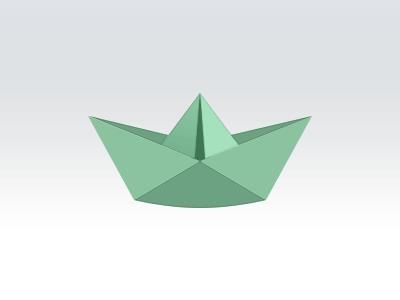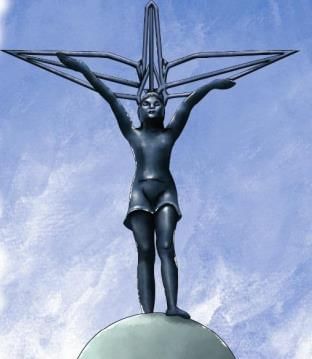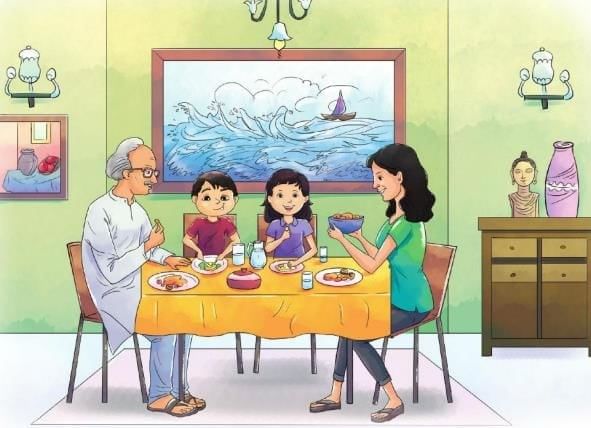A Thousand Origami Cranes Chapter Notes | English Class 4 ICSE PDF Download
| Table of contents |

|
| Introduction |

|
| Key Points |

|
| Explanation |

|
| Message |

|
Introduction
This chapter tells the story of a special Japanese art called origami, which means folding paper to make small shapes. It starts with two children, Reem and Taher, who watch a movie about a girl named Sadako Sasaki. Sadako became sick because of the effects of the bomb and tried to make paper cranes to get good luck. The chapter also talks about how origami helps in learning and how it is important in Japanese culture. Reem’s mother, Revathi, an artist, explains more about paper cranes and a famous origami maker named Akira Yoshizawa. The story shows how folding paper cranes can bring hope and peace.

Key Points
This story is about:
- Origami is the art of folding paper to create small shapes.
- A German educator thought origami helps children learn about shapes.
- Sadako Sasaki, a Japanese girl, got sick from a bomb and folded paper cranes for good luck.
- In Japan, folding a thousand paper cranes is believed to bring good luck or a wish.
- Cranes are seen as lucky and can live for a thousand years in Japanese stories.
- Revathi, an artist, tells about a memorial for Sadako and the meaning of cranes.
- Akira Yoshizawa used origami to teach geometry and created a special method called wet-folding.
- Paper cranes are used as decorations and gifts in Japan.
- Today, paper cranes also stand for peace and harmony around the world.
- Reem, Taher, Revathi, and her father start folding paper cranes together.
Explanation
Origami is a Japanese art where the word comes from "ori" meaning folding and "kami" meaning paper. It involves making small figures by folding paper, traditionally without tools like glue or scissors, though modern artists sometimes use technology. Friedrich Fröbel, a German educator who created the kindergarten system, saw origami as a great way to teach children about geometric shapes like squares and triangles.
The story begins during summer vacation when Reem and Taher watch a movie at Reem’s house about Sadako Sasaki. Sadako was just two years old when atom bombs fell near her home in Japan, about two kilometers away. When she was eleven, she started showing signs of a sickness called "bomb disease" due to radiation.
Doctors said she might live only one more year. In Japan, there’s a belief that folding a thousand paper cranes brings good luck, so Sadako used any paper she could find to make them. She managed to fold about six hundred cranes before she passed away, and her friends and well-wishers completed the rest, burying them with her.
This moved Reem and Taher deeply. They asked Revathi, Reem’s mother who is an artist and enjoys painting and origami, for more information. Revathi put down her paintbrush and explained that Sadako has a memorial in a park in Japan where people still fold cranes to honor those who died from radiation sickness. She told them that in Japan, cranes are seen as lucky, much like dragons or tortoises, which are believed to live a thousand years.
Some people think folding a thousand cranes grants a wish, while others believe it brings health and recovery to the person folding them. These cranes are often tied together with strings, used to decorate homes, and given as popular gifts. When Reem asked if cranes really bring good luck, Revathi said she likes to believe they do and added that today they also represent world peace and harmony. Their conversation was paused when Revathi’s father called them for lunch, inviting them to continue the stories over the meal.

During lunch, Revathi introduced Akira Yoshizawa, a man from Japan who worked in a factory teaching juniors basic geometry. He used origami to make learning easier because he had learned it as a child and found it helpful. His work was shown in cities like Tokyo, New York, and Amsterdam. Yoshizawa created a method called wet-folding, where paper is made slightly wet before folding to make it soft and easier to shape into figures. This method uses thicker paper than regular origami paper.
Revathi explained that regular origami paper is usually colored on one side and white on the other, and the folding is done to show or hide the colored side based on the design. After lunch, Reem, Taher, Revathi, and her father sat at a worktable to fold paper. Taher expressed their wish to make a thousand cranes, and Revathi and her father agreed to help. Reem suggested inviting other kids to join, believing it would bring good luck to everyone.
Message
The chapter teaches us about hope, kindness, and peace. Sadako’s effort to fold cranes shows how people can find strength even in tough times. It also shows how origami brings people together and helps them learn. The idea of paper cranes as a symbol of peace reminds us to live in peace and avoid fights. Folding cranes with others, like Reem and Taher do, spreads happiness and good wishes.
New Words with Meanings
- Radiation sickness: A sickness caused by harmful chemicals from a bomb.
- Symptom: A sign that shows someone is sick.
- Touching: Something that makes you feel sorry or kind.
- Promptly: Doing something quickly without waiting.
- Memorial: A statue or place to remember a person or event.
- Auspicious: Something that is lucky.
- Harmony: Living together without fights or disagreements.
- Interrupted: Stopping something for a short time.
- Exhibited: Showing something to people.
- Dampened: Making something a little wet.
- Reveal: Showing something that was hidden.
- Conceal: Hiding something.
FAQs on A Thousand Origami Cranes Chapter Notes - English Class 4 ICSE
| 1. What is the significance of the title "A Thousand Origami Cranes"? |  |
| 2. How does the act of folding origami cranes relate to themes of hope and resilience? |  |
| 3. What historical events are connected to the legend of the thousand origami cranes? |  |
| 4. How can the practice of folding origami cranes be therapeutic? |  |
| 5. In what ways has the story of the thousand origami cranes influenced modern culture? |  |














